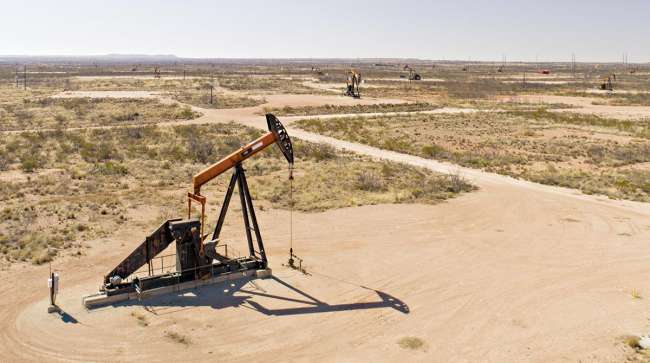Pumpjacks operate on oil wells in the Permian Basin in Crane, Texas. (Daniel Acker/ Bloomberg News)
The U.S. sees domestic crude production declining next year for the first time since 2021 in a blow to President Donald Trump’s push for American energy dominance.
Output is now expected to slip to 13.37 million barrels a day in 2026 from about 13.42 barrels a day from 2025, according to the Energy Information Administration’s Short-Term Energy Outlook released June 10.
Trump has said American oil producers would “drill, baby, drill” and declared an energy emergency early in his second term in a bid to boost production.
June #STEO forecasts:
We expect the Brent crude oil price to fall to near $60/barrel by the end of the year and to average about $59 per barrel in 2026.
We expect the low price of crude oil to affect:
🔵 U.S. crude oil production
🔵 Retail gasoline prices pic.twitter.com/0TZA0OvXXg— EIA (@EIAgov) June 10, 2025
But several shale companies have warned that weak oil prices would take a toll on output, with producers including Diamondback Energy Inc. saying production has already peaked.
With fewer active drilling rigs, U.S. operators will drill and complete fewer wells through 2026, the EIA estimated. Already, the number of rigs drilling for crude in the U.S. plummeted to the lowest in about four years as shale explorers brace for weakening global oil demand.
U.S. shale production will be about 11.09 million barrels a day next year, down from a previous projection of 11.25 million, driven by a slowdown in the prolific Permian Basin, the EIA said.

In another sign of slowing activity in the shale patch, operators expanded their supply of pre-drilled wells for a fourth straight month, marking the longest streak of expansion for drilled-but-uncompleted wells since the early days of COVID five years ago, according to EIA figures. The DUC count — which rose by 25 to 5,319 in May — tends to rise when the shale sector wants to wait out low oil prices and then frack when they get higher.
Meanwhile, offshore output is set to grow to 1.85 million barrels per day in 2026, up roughly 40,000 barrels from last month’s forecast, mitigating the impact of reduced activity in other crude-producing regions.
Global oil demand for this year is expected to grow more slowly, the agency said. Consumption will increase by 800,000 barrels a day to 103.5 million barrels a day, versus a previous forecast for demand to grow 1 million barrels a day, the EIA said.
In another sign of a pending glut, the EIA also projects an inventory buildup of more than 800,000 barrels a day this year. That’s the largest since it began publishing an estimate for 2025, in January last year.






